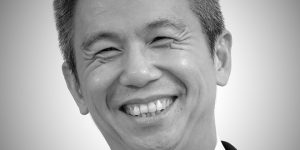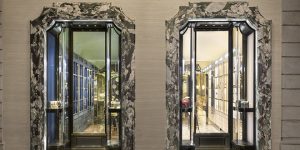Business of Luxury: Temasek Holdings Bought a 30% stake in Stone Island. Here are some local fashion brands they should consider.
The next Singapore Airlines could be in the wings but with Temasek’s acquisition of Stone Island, it seems that local brands are being overlooked. Here are some Singaporean brands the Holding company could consider.

In 1937, a little known airline was formed by British Imperial Airways, Straits Steamship Company and Ocean Steamship company of Liverpool. That said, this airline didn’t make its maiden flight till May 1947, not the most auspicious of starts but nevertheless it persisted through wars, through separation, this fledgling airlines became incorporated as Singapore Airlines on 28 January 1972. Today, we might recognise the flagship carrier of Singapore as one of the most reputed of airlines in the world but to think its success and recognition is the result of the original Pierre Balmain sarong kabayas, Ian Batey’s Singapore Girl, its impeccable service or its fleet, is to ignore one prime element – backing of one singularly major shareholder – Temasek Holdings.
Incorporated under the Singapore Companies Act in 1974, Temasek Holdings was mandated to own and commercially manage investments and assets previously held by the Singapore Government. Effectively, Temasek Holdings was going to be managing investments made in the first decade of nation building since our separation in 1965, leaving the Ministry of Finance to focus on its core role of policymaking and regulations.

With an initial portfolio of S$354 million comprising shares in companies, start-ups and joint ventures, they owned 57% of Singapore Airlines, making Temasek Holdings the largest shareholder. Today, Temasek’s portfolio as at 31 March 2017 was S$275 billion (US$197 billion) with investment, divestment and business decisions are directed by its Board and management.
Business of Luxury: Temasek Holdings Just Bought a 30% stake in Stone Island. Remember the time they were backing local brands like Singapore Air?

Temasek Holdings portfolio of investments by sector and geography. Singapore is meant to have the majority share. Lifestyle as a sector does not feature strongly.
On 1 August 2017, Business of Fashion reported that Singapore-based investment company Temasek had acquired a 30% stake in Sportswear Company S.p.A, owner of the Stone Island brand for an undisclosed sum.
“Temasek guarantees the continuity and the autonomy of the company’s management team which, in our case, has proven to successfully face and overcome our sector’s challenges. With this operation I wanted to both capitalize the work done in 35 years and to team with a partner to face the increasingly complex opportunities proposed by the markets.” – Brand president Carlo Rivetti, Stone Island
But this wasn’t the first fashion investment made by Temasek Holdings, in May 2016, Singapore’s national investment company contributed to Farfetch’s $110 million Series F funding round along with IDG Capital Partners (one of China’s first venture capital firms) and Eurazeo. Stone Island now joins the Temasek Holdings portfolio of consumer fashion and retail brands including Moncler (acquired in July 2016) and spent S$642m on Swiss-based airport retailer Dufry (acquired May 2015). (Update: Now it also looks like Temasek Holdings is set to acquire SoundCloud).

Temasek Holdings recently acquired a 30% stake in Stone Island
With each high profile fashion, lifestyle or retail brand investment, Temasek Holdings often stated that they had intended to support these brands “in the long term as they continued global expansion”.
According to Emmanuel Daniel, founder of The Asian Banker, one of the most respected banking intelligence companies in the industry, he likened that Temasek Holdings was very much unlike a pension fund management business because ” objectives of a pension fund are set for them by their boards and all they need to do is to keep it on the straight and narrow by investing in long term bonds and ensuring the base capital is not eroded” and that with the list of criteria, fund managers are almost “auto-pilot”.
Temasek Holdings on the other hand has “various investment objectives all mixed up with political objectives and the personal vision of the leaders of the country on how to stretch the influence of the fund to achieve other unrelated objectives of the country”.
Based on this assessment, Daniel posits these political objectives often “forces Temasek Holdings to take positions based not on a purely profit motivation, but on broader considerations of what it would consider to be of national interest”, that is to say, non-neutral investing in an asset class like budget airlines by focusing on Singapore brands like Tiger Airways and Jetstar to give them the financial resources for success, an opportunity cost over investing in more successful or better positioned competitors.

Pedro Shoes – was launched initially as an affordable yet luxurious shoe label for men by Charles & Keith, today, it also encompasses women’s shoes and accessories.
Yet, overtime, these objectives changed and for better (or worse), Temasek Holdings began to adopt values of global investment banks and the “investment banking style” of doing things which got Temasek into some ill-advised decisions.
Singaporean Local Brands gone global, missed opportunities by Temasek Holdings?
In 2011, there was some excitement when a fashionable Singaporean homegrown shoe brand Charles & Keith had a 20% stake acquired. At the time, the pre-announcement rumour was that Temasek Holdings was entering the lifestyle segment and it was they who acquired the stake, but as it turns out, it was multinational luxury goods conglomerate Louis Vuitton Moet Hennessy (LVMH). Purchased to the tune of SGD30 million with a valuation of SGD200 million, Charles & Keith joined L Capital Asia (the private equity fund of LVMH) portfolio of other top fashion brands like Marc Jacobs, Dior and Givenchy.

Charles & Keith was founded by two Singaporean brothers in 1996
There are some allegories here – like Singapore Airlines, the brothers Charles and Keith Wong cut their teeth first in their locality, in this instance, their parents’ shop in Ang Mo Kio and then taking that experience, they ponied up SGD100k to launch their namesake brand in Amara Hotel in 1996.
“This partnership means that a luxury giant who is responsible for major international brands like Louis Vuitton, Givenchy, and Celine saw value and worth in investing in a local and homegrown Singaporean brand.” – Kristine Lim, AVP for franchisee for Charles & Keith Philippines in a comment to The Philippine Star
By the time LVMH’s equity fund came knocking on their doors, Charles & Keith (and Pedro Shoes) already had more than 300 stores across 26 countries. They were eventually convinced by LVMH’s pitch that with their L Capital’s capital injection, they could help Charles & Keith compete in China, India, the United States and Western Europe. But Charles & Keith wasn’t the only brand acquired by luxury retailer LVMH Moet Hennessy Louis Vuitton.
Since 2009 (in addition to Charles * keith), L Capital Asia had acquired these Singapore brands as well:
- 90% of Crystal Jade Group estimated to be worth US$100 million
- 51% of restaurant-club Ku De Ta, also estimated to be worth more than $100 million
- In 2011, a 51% stake of Heng Long Tannery, valued at $160 million
- In 2009, paying $112 million for a 26.3% stake in Sincere Watch & Jewellery. By 2012, Pollyanna Chu’s Be Bright private equity fund would eventually acquire the company and 75% of Sincere Watch Hong Kong.
Thus, the question remains, there is no lack of Singaporean brands who could benefit from the capital, resources and even mentorship of Temasek Holdings, wherefore art thou? The next Singapore Airlines could be in the wings but it seems that local brands are being overlooked. Granted, fashion and lifestyle isn’t the investment fund’s forte but wouldn’t there be a base of familiarity and financial clarity (from a local tax reporting perspective) from home grown brands?

Homegrown Charles & Keith is about to launch their Disney collaboration – Alice in Wonderland collection of mother and daughter shoes – how imaginative is that?
Furthermore, according to Dealstreetasia, “The investment comes at a time when divestments by the state investor are outpacing its investments. Increasingly, Temasek is making more private market bets amid pressure for higher investment returns that see it making larger bets and adding more unlisted stocks to its portfolio.” During the period, Temasek’s divestments of S$28 billion almost equalled its investments of S$30 billion.
In 2016, Temasek reported a S$24 billion drop in net portfolio value with a one-year Total Shareholder return of – 9.02% as compared to 19% in 2015. In a statement to Channel News Asia, Executive Director and CEO of Temasek International, Lee Theng Kiat said that “the record divestment reflected its plan to reshape its portfolio, in line with what it saw as longer-term trends in financial, life sciences sectors as well as the digital space.”
Investing in fashion labels like Stone Island and Moncler seem contrary to that position, especially when the luxury sector has taken a bit of a beating in recent years. That said, Stone Island is profitable, generating US$97 million in global sales revenue, up 10% from 2014 reports with profits for 2016 up 26% from 2015 at US$129 million.
Temasek Holdings’ focus on spotting trends in the unlikeliest of places to stay ahead in a changing economy reflects in 30% stake acquisition of European streetwear brand Stone Island.
Europe has recently shown above-trend acceleration courtesy global and domestic demand. Time to invest is just right as European Central Bank (ECB) is predicted to go conservative in their accommodative monetary policy next year.
Temasek Holdings sees opportunity in growing global middle income population’s preference for fashion. Fashion also sits at the crux of consumer and technology, two big investment portfolios for Temasek Holdings, and is globally a $2.4 trillion industry with 5.5% annual growth rate (according to McKinsey Global Fashion Index). Therefore, earlier this year, Temasek invested in leading online fashion retail platform Farfetch, as well as acquired a 26.8 percent stake in Italian fashion firm Moncler.
Streetwear in the new fashion mainstream. With 26% annual growth, high usage of technology in their clothing material, radical designs, strong brand community and Drake as their major endorser – Stone Island becomes a perfect investment opportunity for Temasek Holdings. – Prashant Saxena, Consumer Researcher
What local fashion brands could Temasek Holdings invest in?
Assuming that they’re looking to venture deeper into fashion brands, perhaps Temasek could help some these local brands which Luxuo believes has the potential to go global, recalling the early company objective of incubating home-grown brands towards a position of global growth.

Singapore label Ong Shunmugam by designer Priscilla Shunmugam
Ong Shunmugam – From Cheongsam to Sari, designer Priscilla Shunmugam’s interpretative work on regional sartorial garb (albeit women’s couture) is certainly well placed to represent “Designed in Singapore” fashion with an Asian perspective.

Collate the Label, another Singaporean brand
Collate The Label – Singaporean founder Velda Tan envisioned Collate The Label as a fuss-free, fashion-forward, effortlessly stylish ensemble with asymmetry and striking colours. Given the relative ease of matching and pairing with literally anything designed by Collate, it’s a sure fire hit globally (given that the majority of the world isn’t born with innate fashion sensibilities).

Sven and Kane started In Good Company after leaving Alldressedup
In Good Company – Having left Alldressedup in 2013, Sven and Kane started In Good Company to create distinctive wearable pieces driven by simple yet essential tailoring, catering to women and their fashion quirks. More importantly, In Good Company makes it a point to maintain a network of likeminded designers, resulting in successful collaborations in a variety of genres including accessories and perfume.

Biro’s collection is proudly designed in Singapore but made in Japan
Biro Company – Founded by brothers Keng How and Kage Chong, Biro Company’s collection of menswear staples like garbadine jackets and tailored shirts are designed in Singapore and made in Japan – the resulting garments have local feel with global appeal, with quality to match.

The sensuous Singaporean label – Aijek
Aijek – Created in 2010, self-taught designer Danelle Woo founded Aijek to create a line of beautiful, easy and unapologetically feminine pieces with sustainable high quality fabrics. Woo works with natural fibres such as silk with elegant feminine silhouettes – the end result? timeless, effortless sartorial stunners.
Temasek Holdings can do a lot better than let these opportunities get snapped up by foreign equity companies like LVMH. #BuyLocal









